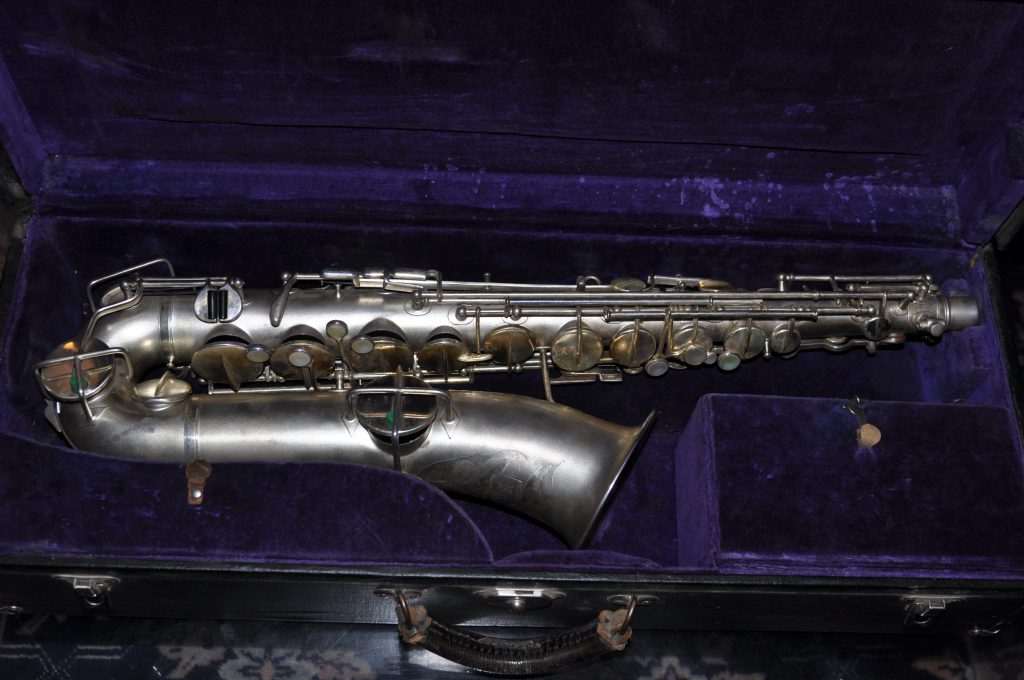“New” Saxophone

For those of you who don’t know yet, last week I was officially laid off at Eltron after nearly 12 years. It’s a sad turn of events, but I’m hoping that it leads to some wonderful new possibilities. I’ve enjoyed my time at Eltron immensely—especially due to the many fantastic people I’ve met and worked alongside over the years and the fantastic things I’ve learned in the process. I’ll be sure to let you all know when I find the right next thing.
About a week before the executioner’s axe came down, I also bought a “new” saxophone; great timing, eh? I say “new” because it’s actually a vintage horn from 1921, according to the serial number. It’s a bit of an unusual horn by modern standards in that it’s pitched in the key of C. Most modern saxes are in either Eb (think alto and bari) or Bb (like the soprano and tenor). The C-melody (pitched 1 major 2nd above the tenor or a minor 3rd below the alto) had a period of fantastic popularity in the ’20s–’30s, but the bottom in that market pretty much collapsed, and they basically haven’t been produced since. Part of the reason is that nothing is written for the C-melody from an ensemble perspective, so it’s sorta useless. Unless, like me, you play a bunch of stuff that is in very odd keys and requires extreme transposition. Think vocal stuff at church and rock bands with lots of guitarists. So that’s where I plan to make the most use of the horn.

For those who are interested, the horn was manufactured by the Buescher Co. (pronounced like Bisher) in Elkhart, Indiana, which used to be the center of musical instrument manufacturing for the country. It was a nice horn in its day with a beautiful silver-plate finish and a thin gold coating inside the bell. The finish is in pretty darn good shape, but a previous owner tried some very ill-advised restoration work—resulting in some weird yellowish gunk on a bunch of the pad cups. Oddly, the material melts/burns when you try to float pads (sax pads are typically adhered to the cups using shellack that needs to be softened for adjustments).

So, after getting a few of the pads replaced, the octave mechanism straightened (it was badly bent when I bought the horn), and the neck cork replaced (totally gone when I bought it) the horn looked a bit worse. However, I have removed a few of the keys and discovered that the gunk does come off without damaging the underlying finish.
I’ve been having a bit of fun playing it. The pads seem to seal pretty well (despite most being the originals and now over 90 years old), but they are a bit soft and have a poor feel. The sound isn’t bad either. It’s a pretty dark sound with the vintage mouthpiece that came with the horn (an eburnated—that means hard rubber—Conn eagle. I had to find a different ligature as the one that came on the mouthpiece is clearly not the original and didn’t really fit. I also need to make a decision on whether to use tenor (or bass clarinet) reeds on the mouthpiece as is, reface the piece to better fit modern reeds, or get a modern C-melody mouthpiece, but as all of the above require money, that’s a decision I can push off to tomorrow.

I’ve also decided that as soon as I get a new job, I’m going to buy a complete set of new pads, strip all of the keywork, and try my hand at an overhaul. I think a set with resonators might help to brighten up the sound a bit, and I might get a bit more benefit from adding a baffle to the large-chamber mouthpiece that came with the horn. Basically it should be a great horn to experiment on in order to customize my sound. Since it isn’t a terribly valuable horn, it makes a decent practice horn for restoration work too. I’ll add some pics as the project progresses. For now, here’s an audio file of what it sounds like. This was recorded playing the sax with an alto mouthpiece and a Hahn synthetic reed. Not a perfect match for the horn. There’s a bit of Phoebe chattering away in the background as well as a couple screams from Benjamin. Maybe not everyone is a fan of the new sax!
By the way, I recorded this pretty quickly using the little Zoom H1 Handy Recorder Jess got me for Christmas and edited it down with Audacity. Thanks for the cool gift, Honner!
Desafinado – Antonio Carlos Jobim
Dave Gribble, C-melody Sax
2 Comments
Grammie
Gee David, I think it has a pretty sound. sounds like this will be a fun project once you get started. Love the snow pictures too! Guess we are about to get more of the white stuff tomorrow night….they say we could be measuring in feet this time! It has been a long winter back in PA.
Dave
Wow, that sounds like fun!